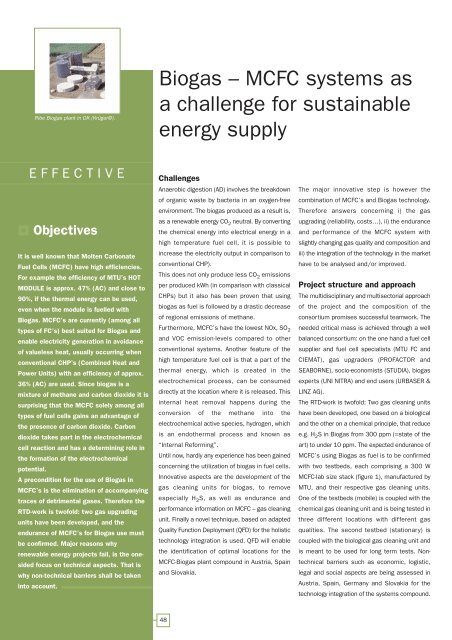European Bio-Energy Projects
European Bio-Energy Projects
European Bio-Energy Projects
Create successful ePaper yourself
Turn your PDF publications into a flip-book with our unique Google optimized e-Paper software.
Ribe <strong>Bio</strong>gas plant in DK (Krüger©).<br />
EFFECTIVE<br />
Objectives<br />
It is well known that Molten Carbonate<br />
Fuel Cells (MCFC) have high efficiencies.<br />
For example the efficiency of MTU’s HOT<br />
MODULE is approx. 47% (AC) and close to<br />
90%, if the thermal energy can be used,<br />
even when the module is fuelled with<br />
<strong>Bio</strong>gas. MCFC’s are currently (among all<br />
types of FC’s) best suited for <strong>Bio</strong>gas and<br />
enable electricity generation in avoidance<br />
of valueless heat, usually occurring when<br />
conventional CHP’s (Combined Heat and<br />
Power Units) with an efficiency of approx.<br />
36% (AC) are used. Since biogas is a<br />
mixture of methane and carbon dioxide it is<br />
surprising that the MCFC solely among all<br />
types of fuel cells gains an advantage of<br />
the presence of carbon dioxide. Carbon<br />
dioxide takes part in the electrochemical<br />
cell reaction and has a determining role in<br />
the formation of the electrochemical<br />
potential.<br />
A precondition for the use of <strong>Bio</strong>gas in<br />
MCFC’s is the elimination of accompanying<br />
traces of detrimental gases. Therefore the<br />
RTD-work is twofold: two gas upgrading<br />
units have been developed, and the<br />
endurance of MCFC’s for <strong>Bio</strong>gas use must<br />
be confirmed. Major reasons why<br />
renewable energy projects fail, is the onesided<br />
focus on technical aspects. That is<br />
why non-technical barriers shall be taken<br />
into account.<br />
<strong>Bio</strong>gas – MCFC systems as<br />
a challenge for sustainable<br />
energy supply<br />
Challenges<br />
Anaerobic digestion (AD) involves the breakdown<br />
of organic waste by bacteria in an oxygen-free<br />
environment. The biogas produced as a result is,<br />
as a renewable energy CO2 neutral. By converting<br />
the chemical energy into electrical energy in a<br />
high temperature fuel cell, it is possible to<br />
increase the electricity output in comparison to<br />
conventional CHP).<br />
This does not only produce less CO2 emissions<br />
per produced kWh (in comparison with classical<br />
CHPs) but it also has been proven that using<br />
biogas as fuel is followed by a drastic decrease<br />
of regional emissions of methane.<br />
Furthermore, MCFC’s have the lowest NOx, SO2 and VOC emission-levels compared to other<br />
conventional systems. Another feature of the<br />
high temperature fuel cell is that a part of the<br />
thermal energy, which is created in the<br />
electrochemical process, can be consumed<br />
directly at the location where it is released. This<br />
internal heat removal happens during the<br />
conversion of the methane into the<br />
electrochemical active species, hydrogen, which<br />
is an endothermal process and known as<br />
“Internal Reforming”.<br />
Until now, hardly any experience has been gained<br />
concerning the utilization of biogas in fuel cells.<br />
Innovative aspects are the development of the<br />
gas cleaning units for biogas, to remove<br />
especially H2S, as well as endurance and<br />
performance information on MCFC – gas cleaning<br />
unit. Finally a novel technique, based on adapted<br />
Quality Function Deployment (QFD) for the holistic<br />
technology integration is used. QFD will enable<br />
the identification of optimal locations for the<br />
MCFC-<strong>Bio</strong>gas plant compound in Austria, Spain<br />
and Slovakia.<br />
48<br />
The major innovative step is however the<br />
combination of MCFC’s and <strong>Bio</strong>gas technology.<br />
Therefore answers concerning i) the gas<br />
upgrading (reliability, costs…), ii) the endurance<br />
and performance of the MCFC system with<br />
slightly changing gas quality and composition and<br />
iii) the integration of the technology in the market<br />
have to be analysed and/or improved.<br />
Project structure and approach<br />
The multidisciplinary and multisectorial approach<br />
of the project and the composition of the<br />
consortium promises successful teamwork. The<br />
needed critical mass is achieved through a well<br />
balanced consortium: on the one hand a fuel cell<br />
supplier and fuel cell specialists (MTU FC and<br />
CIEMAT), gas upgraders (PROFACTOR and<br />
SEABORNE), socio-economists (STUDIA), biogas<br />
experts (UNI NITRA) and end users (URBASER &<br />
LINZ AG).<br />
The RTD-work is twofold: Two gas cleaning units<br />
have been developed, one based on a biological<br />
and the other on a chemical principle, that reduce<br />
e.g. H2S in <strong>Bio</strong>gas from 300 ppm (=state of the<br />
art) to under 10 ppm. The expected endurance of<br />
MCFC’s using <strong>Bio</strong>gas as fuel is to be confirmed<br />
with two testbeds, each comprising a 300 W<br />
MCFC-lab size stack (figure 1), manufactured by<br />
MTU, and their respective gas cleaning units.<br />
One of the testbeds (mobile) is coupled with the<br />
chemical gas cleaning unit and is being tested in<br />
three different locations with different gas<br />
qualities. The second testbed (stationary) is<br />
coupled with the biological gas cleaning unit and<br />
is meant to be used for long term tests. Nontechnical<br />
barriers such as economic, logistic,<br />
legal and social aspects are being assessed in<br />
Austria, Spain, Germany and Slovakia for the<br />
technology integration of the systems compound.

















